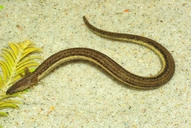|
Pseudobranchus striatus (LeConte, 1824)
Northern Dwarf Siren, Gulf Hammock Dwarf Siren, Slender Dwarf Siren, Borad-striped Dwarf Siren | family: Sirenidae genus: Pseudobranchus |
 © 2010 Michael Graziano (1 of 11) |
|
|
|
Description Adult P. striatus have a brownish to black dorsal ground color with parallel yellow or tan stripes running along the back and sides from head to tail tip. There is geographic color variation and two or three subspecies are recognized. Pseudobranchus s. striatus, the broad-striped dwarf siren, has a dark brown to blackish middorsal stripe with a narrow yellow line running down the middle and broader yellow lateral stripes. The venter has a lighter ground color than the back and is heavily mottled with yelow. This subspecies is also considered somewhat stocky in build. Pseudobranchus s. spheniscus, the slender dwarf siren, is smaller and more slim-bodied. This subspecies has a narrow, wedge-shaped head and two (rarely three) narrow tan or yellow lateral stripes. Pseudobranchus s. lustricolus, the Gulf Hammock dwarf siren, is not recognized by all authors; the distribution and affinities of this form merit futher investigation (Moler and Kezer 1993; Petranka 1998). A stocky subspecies, individuals have a dark, broad middorsal stripe containing three narrow yellow stripes. There are two light lateral stripes as well, the upper orangish brown and the lower silvery white. Descriptions from Petranka (1998). Distribution and Habitat Country distribution from AmphibiaWeb's database: United States U.S. state distribution from AmphibiaWeb's database: Florida, Georgia, South Carolina
Life History, Abundance, Activity, and Special Behaviors Courtship and mating have not been observed (Petranka 1998). Fertilization is presumed to be external (Martof 1972 1974; Sever et al. 1996). Eggs are deposited singly, and the oviposition period lasts from early November through March (Petranka 1998). Often locally abundant. Diet consists of aquatic invertebrates, including earthworms, amphipods, chironomids, and ostracods. When semi-permanent pools dry, dwarf sirens aestivate in burrows10-30 cm underground. Individuals are likely to be preyed upon by birds, turtles, alligators, and aquatic snakes. When disturbed, dwarf sirens sometimes emit a high-pitched yelp. See Petranka (1998) and references therein. Trends and Threats The Gulf Hammock dwarf siren has been reliably reported from only three localities in lowland areas in the Gulf Hammock region of Florida. It has apparently not been collected since the original description (based on 11 individuals) in 1951. The restricted range and specialized, aquatic habitat suggest that this form deserves conservation attention, however more data are needed to determine the status of these populations and the relationship of this form to other dwarf sirens (Moler 1992a; 1992b). Relation to Humans Comments
References
Conant, R. and Collins, J. T. (1991). A Field Guide to Reptiles and Amphibians: Eastern/Central North America. Houghton Mifflin, Boston. Martof, B. S. (1972). ''Pseudobranchus, P. striatus.'' Catalogue of American Amphibians and Reptiles. Society for the Study of Amphibians and Reptiles, 118.1-118.4. Martof, B. S. (1974). ''Sirenidae. Sirens.'' Catalogue of American Amphibians and Reptiles. Society for the Study of Amphibians and Reptiles, 151.1-151.2. Moler, P. E. (1992). ''Gulf Hammock Dwarf Siren.'' Rare and Endangered Biota of Florida. Volume 3. Amphibians and Reptiles. Moler, P. E., eds., University Press of Florida, Gainesville, FL, 77-80. Moler, P. E. (ed.) (1992). Rare and Endangered Biota of Florida. Volume 3. Amphibians and Reptiles. University Press of Florida Moler, P. E., and Kezer, J. (1993). ''Karyology and systematics of the salamander genus Pseudobranchus (Sirenidae).'' Copeia, 1993, 39-47. Petranka, J. W. (1998). Salamanders of the United States and Canada. Smithsonian Institution Press, Washington D.C. and London. Sever, D. M., Rania, L. C. and Krenz, J. D. (1996). ''Reproduction of the salamander Siren intermedia Le Conte with especial reference to oviducal anatomy and mode of fertilization.'' Journal of Morphology, 227, 335-348. Originally submitted by: Meredith J. Mahoney (first posted 2000-07-14) Edited by: M. J. Mahoney, Kevin Gin (12/03) (2003-12-04) Species Account Citation: AmphibiaWeb 2003 Pseudobranchus striatus: Northern Dwarf Siren <https://amphibiaweb.org/species/4313> University of California, Berkeley, CA, USA. Accessed Nov 21, 2024.
Feedback or comments about this page.
Citation: AmphibiaWeb. 2024. <https://amphibiaweb.org> University of California, Berkeley, CA, USA. Accessed 21 Nov 2024. AmphibiaWeb's policy on data use. |




 Raffaëlli Account
Raffaëlli Account Map of Life
Map of Life